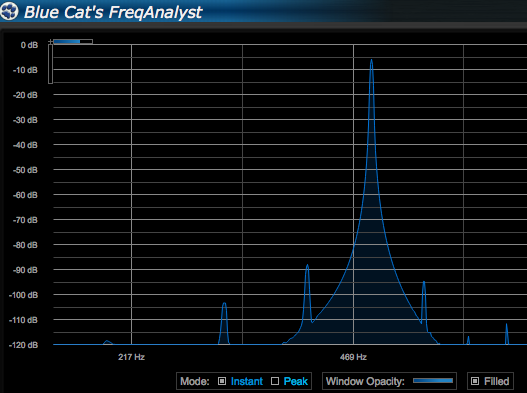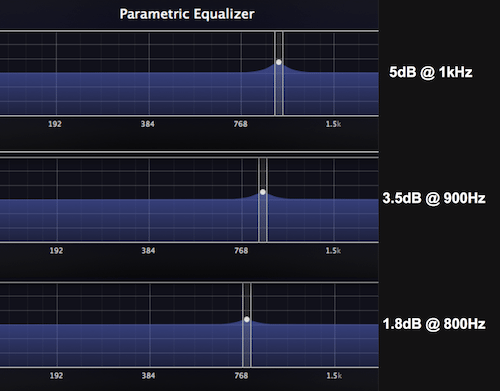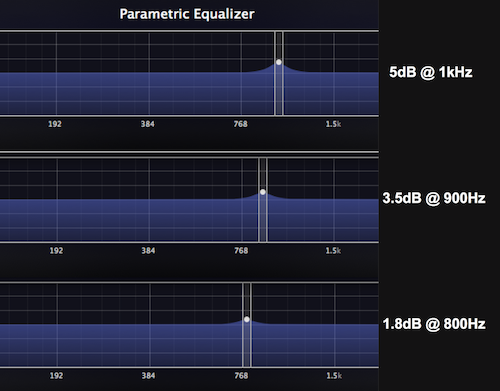Today we’re taking a quick breather in the Frequency Fundamentals series, for an introduction to two important topics for audio engineers: EQ Feathering and Spectrum Analyzers. Once you’re familiar with both of these, you’ll be ready for the final part in the series, on harmonics of sounds.
…Here is the answer to the mystery bonus question at the end of the last article. If you’ll remember, I asked:
What is EQ feathering?
Answer: EQ feathering is a way of applying, or rather spreading equalization through adjacent and tangential frequencies on both sides of the main frequency that you are trying to adjust, thus resulting in a smoother tone curve.
Confusing?
Don’t go away just yet. Let’s look at a working example….it will be a much clearer answer!
EQ Feathering
Let us say that you need a big mid boost at 1k to fatten an anemic rhythm guitar track. Let us also assume that it needs to be a huge boost….somewhere in the 8-10dB range. (I know, ridiculous…but bear with me!)
There are two ways to achieve your mid boost.
- Dial in 1k. Boost the 8-10dB, fine tune. Done. (The obvious solution)
OR
- Dial in 1k. This time boost only 4-6dB.
Now find a couple more frequencies below 1k…let’s say 800Hz and 900Hz. Boost the 900Hz for 2-4dB, then boost the 800Hz for 1-2dB.
Locate a couple frequencies above 1k….let’s say 1100Hz and 1200Hz. Boost the 1100Hz for 2-4dB, and boost the 1200Hz for 1-2dB.
See, now you have a gentle slope gradually increasing and easing into the target 1k, and just as gently, rolling off and decreasing after it. This method of EQ provides a much more natural and smoother sound without artifacts; while providing you with the same tone you were searching for in the first place!
Instead of putting the ENTIRE burden on 1k; you spread it, and distribute it amongst adjacent frequencies, thus yielding a gentler “slope.”
Let’s face it, a big singular spike at 1k will give you the mids you want, but will ultimately cost you – that frequency will stick out like the old sore thumb! With the exception of a few isolated cases, EQ feathering is by far a superior and more natural sounding EQ tactic!
Voila!
That wasn’t so bad now, was it?
Side note: EQ feathering is commonly used in mastering for its gentle approach. There is absolutely no reason that you cannot use it in every day tracking and EQing of individual instruments present in your mix.
The only difference is degree; in the studio/mixing phase you make big boosts or cuts (a few dB), whereas in mastering the boosting and cutting are much more surgical (down to .10 of a dB, or even less) since we’re working on the whole mix. Other than that, EQ feathering is a technique familiar only to a small circle. Well, the circle just got bigger!
Oh, and if you’re wondering how this relates to our ongoing discussion…. read on!
Spectrum Analyzers
A spectrum analyzer is a hardware or software display that accurately visually shows the frequency and amplitude of a signal. This allows for pin-point accurate collection of sound data; thus allowing adjustments to be made over the whole “spectral” balance that might not prove as accurate if using the human ear alone.

Example of a spectrum analyzer, showing a 500Hz tone with side frequencies
[If you’re looking for a software option, you could check out MultiInspectorFree from VertexDSP (VST plugin), or FreqAnalyst from Blue Cat Audio (various plugin types). Lacking DAW software to plug them into? We think Reaper is pretty great.]
This is an excellent tool for our purpose of frequency analysis:
- Play a sound source through your analyzer.
- Watch all the pretty colors dancing around. Just kidding….making sure you’re paying attention! Actually you will see the dancing frequencies.
Yes, I said frequencies, as in multiple, because here you will plainly get to see, what we have been discussing all this time. - You will see the sounds’ multiple frequencies. You will most likely see 3-4 clusters of frequencies clearly standing apart. That, is a compound, or multiple frequency sound. Each of those frequency “stems” represents a different harmonic as well.
A note here: You will quickly notice that even though a fundamental frequency is prominent at, let’s say, 500Hz…you will soon see that is not a clean-cut spike at 500Hz. More than likely it will have a few supporting, tangential frequencies trailing off on either side. Frequencies and sound makeup do not happen in a vacuum; rather they happen in collaboration with each other. At this point, go back to the top of the page and re-read the answer on EQ feathering.
Did you read it?
Good!
This is why EQ feathering will work so well for you; because you aren’t violating the natural physics laws of sound makeup….rather you are operating in concert with them!
With this knowledge under your belt, you’re ready to hear all about compound frequencies and the harmonics of sound….. next time!
Want to tell us about your favourite spectrum analyzer, or share a tip for using them? Have a question this article doesn’t answer? Leave a comment or come tell us in the forums!









